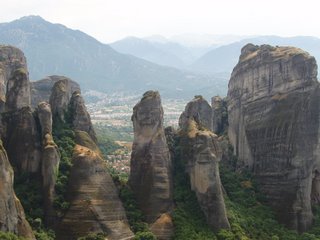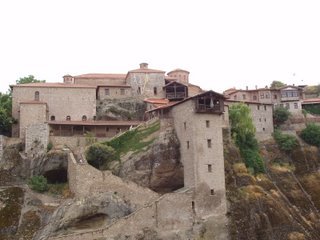Greece was amazing, so much so that I will probably hit you all with a barrage of posts over the next few days chronicling our trip.
You won't be sorry though, because I will include historical tidbits and stunning photographs, starting with breathtaking pictures of Meteora.
Meteora is in a mountainous region of inland Greece, about 4 hours from Athens. The area takes its name from the giant cliffs that dot the landscape. The word Meteora translates to 'rocks in the sky'--the root of our word 'meteor.'
 The massive rock formations are a result of a large body of water that was present thousands of years ago. After the water dried up, the shape of the rocks morphed to form pockets and grooves over centuries of decomposition.
The massive rock formations are a result of a large body of water that was present thousands of years ago. After the water dried up, the shape of the rocks morphed to form pockets and grooves over centuries of decomposition.In the 11th Century, Greek monks were persecuted by Turkish invaders. In order to be able to practice their Orthodox religion, monks built huge monastic outposts on the tops of 21 rock formations in the area. Today, six monasteries are active sites for the practice of Greek Orthodox peity. We visited the St. Stephen Nunnery pictured below.

Nine hundred years ago, the only way to the top of the monasteries was by riding in rope baskets draped over the craggy rocks and pulled the several hundred feet above by your fellow monks. Today, the rope bags are still in use and have been supplemented with rudimentary cable car systems. We saw several monks moving throught the complex in these cable cars.
The monasteries at Meteora are one of the 812 sites listed on the United Nations' compilation of World Heritage sites. These sites are deemed possesions of the global community because of their historical significance.
The pictures barely do them justice. If you ever get to Greece, take the time to see actual 'meteors' with religious and cultural significance.


1 comment:
Cool. Dang it's a good thing you got that book from that old Greek woman about Meteora. I enjoyed reading your concise history of the region.
Perhaps you should become a travel writer...?
Post a Comment